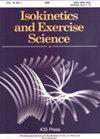The effects of thoracic mobility versus lumbopelvic stabilization exercises on lower extremity flexibility, dynamic balance and proprioception in patients with chronic ankle instability
IF 0.7
4区 医学
Q4 ENGINEERING, BIOMEDICAL
引用次数: 0
Abstract
BACKGROUND: Chronic ankle instability (CAI) presents neuromuscular control and functional performance difficulties. Although ankle-focused rehabilitation is widely practised, the relative effects of exercises targeting thoracic mobility and lumbopelvic stabilization in addressing CAI have not been thoroughly investigated. OBJECTIVE: The study aims to compare the effects of thoracic mobility and lumbopelvic stabilization exercises in patients with CAI. METHODS: The study was designed as a prospective randomized controlled clinical trial. A total of 30 participants (mean age = 31.93 ± 7.31; 21F/9M) who scored 27 points or on the Cumberland ankle instability tool voluntarily were enrolled in the study. The participants were randomly divided into two groups. In addition to the rehabilitation protocols, each participant was given a home exercise program, including ankle-strengthening exercises (3 times a week). The first group trained with thoracic mobility (TM), while the second group did lumbopelvic stabilization (LS) exercises under supervision twice a week for eight weeks. Participants’ pre and post-treatment assessments spanned an 8-week rehabilitation period, during which ankle and hip joint range of motion measurements were obtained using an electronic goniometer. Additionally, dynamic balance was assessed through the Y balance test, while ankle proprioception was evaluated using joint position sense measurements. The flexibility was assessed with an active straight leg raise test. RESULTS: Y balance, CAIT, and active straight leg raise test scores were improved in the eighth week in the thoracic mobility group (p< 0.05), while only active straight leg raise test and CAIT scores were significantly different in the lumbopelvic stabilization group (p< 0.05) according to intra group variables. In comparing the post-treatment scores between the groups, the thoracic mobility group had superior results in the joint position sense test for the right side of the hip and plantarflexion. (hip; TM: 70.71 ± 6.80, LS: 68.76 ± 5.50, plantarflexion; TM: 44.24 ± 7.28, LS: 38.30 ± 5.08). CONCLUSION: The findings suggest that while both interventions are effective in addressing various aspects of ankle instability, the thoracic mobility exercises may offer additional benefits, particularly in enhancing joint position sense, thereby providing valuable insights for the optimization of rehabilitation protocols for individuals with chronic ankle instability.胸廓运动与腰椎稳定运动对慢性踝关节不稳定患者下肢灵活性、动态平衡和本体感觉的影响
背景:慢性踝关节不稳定(CAI)给神经肌肉控制和功能表现带来困难。虽然以踝关节为重点的康复训练已被广泛采用,但针对胸廓活动度和腰椎稳定的训练在解决 CAI 方面的相对效果尚未得到深入研究。目的:本研究旨在比较胸廓活动度锻炼和腰椎稳定锻炼对 CAI 患者的影响。方法:该研究设计为前瞻性随机对照临床试验。共有 30 名参与者(平均年龄 = 31.93 ± 7.31;21 名女性/9 名男性)自愿参加研究,他们在坎伯兰踝关节不稳定性工具中得到 27 分或以上。参与者被随机分为两组。除康复方案外,每位参与者还接受了家庭锻炼计划,包括踝关节强化训练(每周 3 次)。第一组进行胸廓活动度(TM)训练,第二组在指导下进行腰椎稳定(LS)训练,每周两次,持续八周。在为期 8 周的康复期中,对参与者进行了治疗前和治疗后评估,期间使用电子动态关节角度计测量了踝关节和髋关节的活动范围。此外,还通过 Y 平衡测试评估了动态平衡,并通过关节位置感测量评估了踝关节本体感觉。灵活性通过主动直腿抬高测试进行评估。结果:根据组内变量,胸廓活动度组的 Y 平衡、CAIT 和主动直腿抬高测试评分在第八周有所提高(P< 0.05),而腰椎稳定组只有主动直腿抬高测试和 CAIT 评分有显著差异(P< 0.05)。比较各组的治疗后评分,胸廓活动度组在右侧髋关节和跖屈的关节位置感测试中成绩更优。(髋关节;TM:70.71 ± 6.80,LS:68.76 ± 5.50,跖屈;TM:44.24 ± 7.28,LS:38.30 ± 5.08)。结论:研究结果表明,虽然两种干预方法都能有效解决踝关节不稳的各方面问题,但胸廓活动度练习可能会带来更多益处,尤其是在增强关节位置感方面,从而为优化慢性踝关节不稳患者的康复方案提供有价值的见解。
本文章由计算机程序翻译,如有差异,请以英文原文为准。
求助全文
约1分钟内获得全文
求助全文
来源期刊

Isokinetics and Exercise Science
医学-工程:生物医学
CiteScore
1.20
自引率
14.30%
发文量
37
审稿时长
>12 weeks
期刊介绍:
Isokinetics and Exercise Science (IES) is an international journal devoted to the study of theoretical and applied aspects of human muscle performance. Since isokinetic dynamometry constitutes the major tool in this area, the journal takes a particular interest in exploring the considerable potential of this technology.
IES publishes studies associated with the methodology of muscle performance especially with respect to the issues of reproducibility and validity of testing, description of normal and pathological mechanical parameters which are derivable from muscle testing, applications in basic research topics such as motor learning paradigms and electromyography. The journal also publishes studies on applications in clinical settings and technical aspects of the various measurement systems employed in human muscle performance research.
The journal welcomes submissions in the form of research papers, reviews, case studies and technical reports from professionals in the fields of sports medicine, orthopaedic and neurological rehabilitation and exercise physiology.
 求助内容:
求助内容: 应助结果提醒方式:
应助结果提醒方式:


